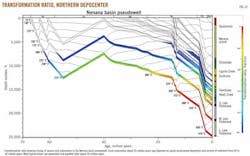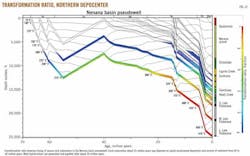Alaska's Interior rift basins: a new frontier for discovery
View Article as Single page
Estimates of thermal maturity indicate the rocks in Nunivak-1 are mainly immature. Table 1 shows six vitrinite reflectance (Ro) analyses with the deepest sample at 10,420 ft yielding Ro = 0.62. Spore color suggests thermal immaturity with colors ranging from pale yellow at shallow horizons to orange below 8,080 ft. The small RockEval S1 peaks (Table 1) suggest the deepest coals in Nunivak-1 (11,080 ft TVD) are still immature. Trace oil shows noted on the mud log below 9,200 ft are thought to reflect the beginnings of oil generation.
Based on measured and reconstructed well temperatures, the geothermal gradient in Nunivak-1 is estimated to be about 1.5° F./100 ft, a value that approximates continental average. This is based on a surface temperature of 35° F. and a reconstructed formation estimate of 205° F. at 11,075 ft.
Geohistory and basin potential
Platte River Associates used the stratigraphic and temperature data from Nunivak-1 to construct a 1D thermal and maturation model of the deepest part of the Nenana basin.
The stratigraphy in Nunivak-1 was expanded to populate a basin center pseudowell to 25,000 ft. Heat flow of 48mW/m2 from 65 to 13 million years was used, then increasing to 59mW/m2 at present. The source characteristics from Nunivak-1 (Table 1) were used to calculate oil volumes.
The maturation results from the basin center pseudowell are shown in Fig. 12. Early maturation around 55 million years depends on about 5,000 ft of sediment deposition and subsequent erosion in the early Eocene, but this history is very poorly constrained. Thermal maturation of most horizons occurs after about 20 million years and continues to the present. From Fig. 12, the top of the transformation window today is estimated at about 12,000 ft.
Source oil expulsion calculations were made by Platte River Associates using 40% Type II kerogen with maturation kinetics similar to the Paris basin and 60% Type III kerogen with maturation kinetics similar to the oil-prone coals of the Mahakam Delta, Indonesia. This integrated source rock was assigned HI = 240, a value identical to the average coal and coaly shale in Nunivak-1.
Assuming TOC = 25%, a conservative value less than the average of 38% for Late Paleocene samples from Nunivak-1, this source will expel oil at about 1,959 bbl/acre-ft. If each of the 27 coaly RockEval samples from Nunivak-1 represents 1 ft of source rock, 27 ft of source will expel about 34 million bbl/sq mile. The gravity inversion depth map (Fig. 3) shows about 240 sq miles where sedimentary rocks are below 15,000 ft in the part of the Nenana basin north of the Nunivak-1 well, and 27 ft of source rock over 240 sq miles would expel 8.1 billion bbl of oil or oil equivalent. These large expulsion volumes are clearly sufficient to potentially charge giant fields.
Alternatively, the eight deepest samples, all below 10,800 ft, have an average HI of 284. An integrated source model of 85% Type II and 15% Type III kerogen has an HI = 285 and expels oil at 2,338 bbl/acre-ft. If each sample represents 2 ft of source rock, then 5.7 billion bbl of oil or oil equivalent is potentially expelled in the northern Nenana basin. Deeper portions of the basin south of Nunivak-1 were not assessed and have additional potential.
Displaying 5/6
View Article as Single page

